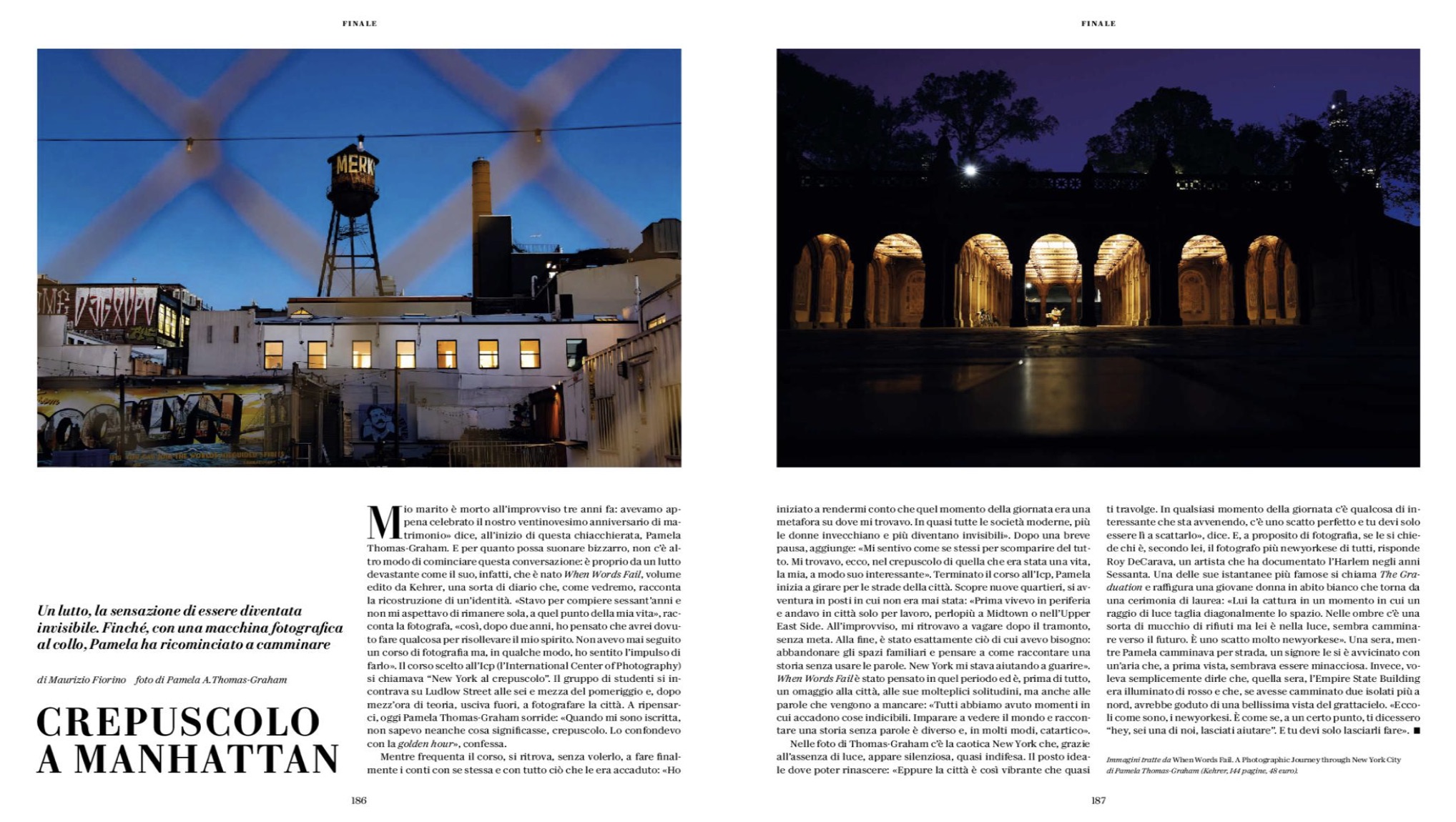Pamela Thomas-Graham’s When Words Fail was featured in the Italian magazine D La Repubblica, marking the first international press coverage of the book.
Titled “Crepuscolo a Manhattan” (Twilight in Manhattan), the article shares the emotional origin story of the book — a project born not from a plan, but from grief. After the sudden loss of her husband, Pamela began photographing New York City at dusk, a time of day she describes as a metaphor for the space she found herself in: reflective, quiet, in-between.
The article traces her journey from a photography class at ICP to solitary walks through unfamiliar neighborhoods, capturing the stillness and solitude of twilight. With references to Roy DeCarava and a reverence for the unseen rhythms of city life, it frames When Words Fail as both a tribute to New York and a meditation on presence, absence, and starting over.
“Learning to see the world and tell a story without words is different and, in many ways, cathartic.”
Though the article is not available online, you can view a translated version and visual from the printed feature below.
Translation
TWILIGHT IN MANHATTAN
A loss, the feeling of becoming invisible. Until, with a camera around her neck, Pamela started walking again.
by Maurizio Fiorino, photos by Pamela A. Thomas-Graham
“My husband passed away suddenly three years ago: we had just celebrated our twenty-ninth wedding anniversary,” says Pamela Thomas-Graham at the start of this conversation. As strange as it may sound, there’s no other way to begin this discussion. It was from her devastating loss, after all, that When Words Fail was born, a book published by Kehrer, a sort of diary that, as we will see, tells the story of rebuilding an identity. “I was about to turn sixty, and I didn’t expect to be left alone at that point in my life,” the photographer recalls. “So, after two years, I thought I should do something to lift my spirits. I had never taken a photography course before, but somehow, I felt the urge to do it.”
The course she chose at ICP (the International Center of Photography) was called New York at Twilight. The group of students would meet on Ludlow Street at 6:30 p.m., and after half an hour of theory, they would go out to photograph the city. Looking back now, Pamela Thomas-Graham smiles: “When I signed up, I didn’t even know what twilight meant. I confused it with the golden hour,” she admits.
While attending the course, she found herself, almost unintentionally, finally coming to terms with herself and everything that had happened to her: “I began to realize that that time of day was a metaphor for where I was. In almost all modern societies, the older women get, the more invisible they become.” After a brief pause, she adds, “I felt like I was about to disappear completely. I was in, well, the twilight of what had been my life, a life that, in its own way, had been interesting.”
After completing the ICP course, Pamela began wandering the streets of the city. She discovered new neighborhoods and ventured into places she had never been before: “I used to live in the suburbs and only came into the city for work, mostly in Midtown or the Upper East Side. Suddenly, I found myself wandering aimlessly after sunset. In the end, it was exactly what I needed: to leave familiar spaces and think about how to tell a story without using words. New York was helping me heal.”
When Words Fail was conceived during that period, and it is, above all, a tribute to the city, to its multiple forms of solitude, but also to the words that fall short: “We’ve all had moments when unspeakable things happen. Learning to see the world and tell a story without words is different and, in many ways, cathartic.”
In Thomas-Graham’s photos, there is the chaotic New York that, thanks to the absence of light, appears silent, almost defenseless. The perfect place to be reborn: “Yet the city is so vibrant that it almost overwhelms you. At any time of day, there’s something interesting happening, there’s a perfect shot, and you just have to be there to take it,” she says. And speaking of photography, when asked who, in her opinion, is the most quintessential New York photographer, she replies Roy DeCarava, an artist who documented Harlem in the 1960s. One of his most famous snapshots is called The Graduation, which depicts a young woman in a white dress returning from a graduation ceremony: “He captures her in a moment where a ray of light cuts diagonally across the space. In the shadows, there’s a sort of pile of garbage, but she’s in the light, walking toward the future. It’s a very New York moment.”
One evening, as Pamela was walking down the street, a man approached her with an expression that, at first glance, seemed menacing. Instead, he just wanted to tell her that the Empire State Building was lit up in red that night and that if she walked two blocks north, she would have a beautiful view of the skyscraper. “That’s how New Yorkers are. It’s as if, at a certain point, they say to you, ‘Hey, you’re one of us, let us help you.’ And you just have to let them.”


Leave a reply